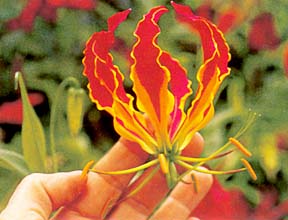Advertisement - Click to support our sponsors.


Dig This![]()
Friday, June 2, 2000

"Poisonous Plants of Paradise"
Toxins in Dieffenbachia, or dumb cane -- the plant with
the patterned leaves -- can cause painful swelling,
blistering and itching.
HAWAII'S flora has a reputation for being benign. Hikers don't have to worry about the mainland scourges of poison oak and poison ivy. Many native plants have no natural defenses, much to their post-contact peril. But a new book reveals a surprising level of lethality is hidden in local foliage. Toxic plants
surprisingly common"Poisonous Plants of Paradise: First Aid and Medical Treatment of Injuries from Hawaii's Plants," by Susan Scott and Craig Thomas, is designed as a resource for identifying these plants and treating the reactions they can produce.
Many of the culprits are commonly known to be poisonous, but are still grown throughout the state. The highway hedge oleander contains a heart toxin that is easily fatal. Our parks are full of be-still trees, or Thevetia peruviana, with its trumpet shaped yellow flowers and a toxicity similar to that found in oleander. Despite their chemistry, however, the authors found few reactions to these plants reported locally, presumably because most people know they are harmful.
FOR THE BOOKSHELF
Title: "Poisonous Plants of Paradise: First Aid and Medical Treatment of Injuries from Hawaii's Plants"
Authors: Susan Scott and Craig Thomas
Publisher: University of Hawai'i Press
Cost: $19.95
In fact, Thomas stressed plant-related poisoning is uncommon in Hawaii. Many of the plants he and Scott -- who also writes the Ocean Watch column Mondays for the Star-Bulletin -- write about are only dangerous if ingested or used as skewers or as fuel for a hibachi or grill.
But some of the plants they found to be toxic are surprising.
For example, few people realize Dieffenbachia is dangerous. The common garden and indoor plant contains calcium oxalate needles that can cause itching, swelling and blistering, which, when they occur in the mouth, can hinder the ability to speak -- hence the common name, dumb cane. Most people exposed to Dieffenbachia recover, but child deaths have been reported overseas.
Hydrangea is another surprise in "Poisonous Plants of Paradise," as the authors realized only too well when they were served salad garnished with its flowers at a local bed and breakfast inn. All parts of the popular flowering plant contain a toxin that turns into cyanide if ingested. Fortunately, the poison tends to first induce severe vomiting and stomach pain, making it possible that it will be evacuated from the body before the lethal switch to cyanide.
Some poisonous plants covered in the book are ingested intentionally by people looking for mind-altering results. Jimsonweed, for example, contains toxins that affect the central nervous system. And five kinds of mushroom toxins are found in local fungi.

The most common source of Hawaii mushroom poisoning is Chlorophyllum molybdites, which smells and tastes good but causes vomiting and diarrhea. The more serious threat is Amanita marmorata, a pleasant looking white mushroom common throughout the state that has caused serious illness in at least one woman in Hawaii, killed at least two dogs locally, and has been fatal to people on the mainland."There's some really lethal stuff around here that we walk by everyday and I had no idea," said Scott.
Botany was new ground for the writers, who published "All Stings Considered," a guide to treating marine injuries, in 1997. Following the release of that book, people would call them to ask about things like mango rash. They decided a new book was in order.
Many of the threats outlined in the book present a special hazard to small children, who are more likely than the rest of us to put unknown substances into their mouths.
For gardeners whose yards are frequented by children, Scott recommends avoiding or removing any plants with the toxalbumin class of poisons, which include black-eyed susan beans (rare except for isolated areas of the Big Island), castor bean (common in the wild, but rare in yards), and Jatropha species (popular ornamental shrubs).
"I would absolutely not have the Jatrophas," she said. "I think those are really bad." The plants all have small seeds that kids could easily eat, said Scott. All parts of the plant contain a potentially lethal toxin that can cause bleeding lesions and cell damage.
"I think the value of the book is to have a resource, to have a way to look things up so you know whether something is an emergency or not," said Scott. "Like the Dieffenbachia. You want to get your kid into an (emergency room) and I had no idea.
"I think you just want to be aware of these things," she said.
The book hit the shelves this month and will be joined by its companion, "Poisonous Pests of Paradise," in another month or so.
Gardening Calendar in Do It Electric!
Stephanie Kendrick's gardening column runs Fridays in Today.
You can write her at the Star-Bulletin, P.O. Box 3080, Honolulu 96802
or email skendrick@starbulletin.com